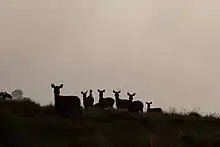| Sambar | |
|---|---|
_male.jpg.webp) | |
| Stag/male | |
_female.jpg.webp) | |
| Doe/female both in Kanha National Park, Madhya Pradesh, India | |
| Scientific classification | |
| Domain: | Eukaryota |
| Kingdom: | Animalia |
| Phylum: | Chordata |
| Class: | Mammalia |
| Order: | Artiodactyla |
| Family: | Cervidae |
| Subfamily: | Cervinae |
| Genus: | Rusa |
| Species: | |
| Subspecies: | R. u. unicolor |
| Trinomial name | |
| Rusa unicolor unicolor | |
| Synonyms | |
| |

Horton Plains National Park, Sri Lanka
The Sri Lankan sambar or Indian sambar (Rusa unicolor unicolor), also known as ගෝනා (gōṇā) in Sinhala, is a subspecies of the sambar that lives in India and Sri Lanka. British explorers and planters referred to it, erroneously, as an elk,[2] leading to place names such as Elk Plain.
Description
This subspecies is the largest sambar subspecies and representative of the Rusa genus, with the largest antlers both in size and in body proportions. Large males weight up to 270–280 kg.
Distribution and habitat
Sambar live in both lowland dry forests and mountain forests. Large herds of sambar roam the Horton Plains National Park, where it is the most common large mammal.
References
Wikimedia Commons has media related to Sambar deer of Sri Lanka.
- ↑ Rusa unicolor
- ↑ Storey, Harry (1907). Hunting & Shooting in Ceylon (PDF). Longmans, Green and Co.
This article is issued from Wikipedia. The text is licensed under Creative Commons - Attribution - Sharealike. Additional terms may apply for the media files.